#lazarus taxon
Explore tagged Tumblr posts
Text

#artists on tumblr#art#illustration#artwork#myart#original art#digital art#takahē#takahe#bird#birds#birb#birbs#digital illustration#animal art#new zealand birds#birdblr#Porphyrio hochstetteri#lazarus taxon#Text Credit: Paul Wignall#Text Credit: Michael Benton
19 notes
·
View notes
Text
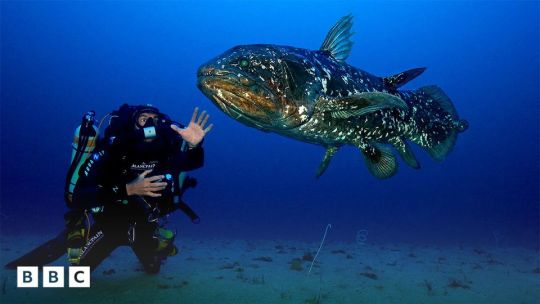
A photographer took the first ever photograph of a living coelacanth. https://bbc.in/4b5oX5q
30 notes
·
View notes
Text

sometimes i be thinking about this guy. he is called "monito del monte" or "colocolo opposum".
we first found a fossil of this dude from 11 million years ago and then when we met this dude we were like "ah shit, check his bones! they match right up with that rock I found".
0 notes
Text
Have you considered that the time tables are just wrong(again)
NEW FISH JUST DROPPED
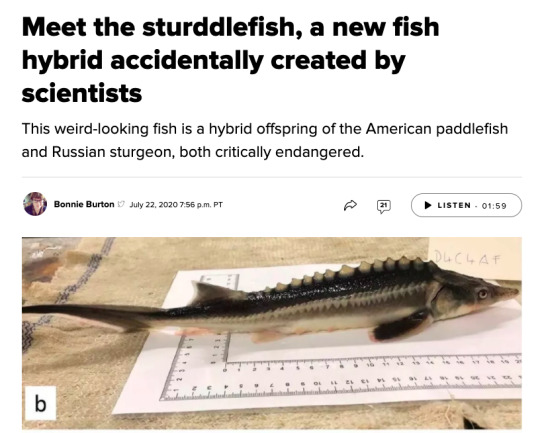
#Coelacanth#Monoplacophoran Mollusks#Lazarus taxon in general#living fossils#Ever think maybe they are just really bad at this timescale stuff?#Funny fish story though#very cool fish!
135K notes
·
View notes
Text
I thought it too obvious to put in the tags on the post but the big reason I drew kaito + coelacanths in that post is because the whole. Look everyone the blue thing is back.
#art talks about stuff#ah yes my favourite lazarus taxon. singing synthesis software from 2014#technically he never went ''extinct'' because piapro studio and stuff but. you get the allegory right
0 notes
Text
I recently found out a show I liked is 10 years old now so to not be the oldest thing on this blog I'm talking coelacanths for Wet Beast Wednesday. Coelacanths are rare fish famed for being living fossils. While that term is highly misleading, it is true that coelacanths are among the only remaining lobe-fined fish and were thought to have gone extinct millions of years ago before being rediscovered in modern times.
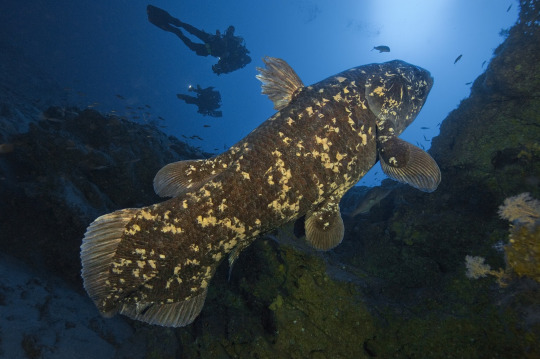
(image id: a wild coelacanth. It is a large, mostly grey fish with splotches of yellowish scales. Its fins are attached to fleshy lobes. It is seen from the side, facing the top right corner of the picture)
Coelacanth fossils had been known since the 1800s and they were believed to have gone extinct in the late Cretaceous period. That was until December 1938, when a museum curator named Marjorie Courtenay-Latimer was informed of an unusual specimen that had been pulled in by local fishermen. After being unable to identify the fish, she contacted a friend, ichthyologist J. L. B. Smith, who told her to preserve the specimen until he could examine it. Upon examining it early next year, he realized it was indeed a coelacanth, confirming that they had survived, undetected, for 66 million years. Note that fishermen living in coelacanth territory were already aware of the fish before they were formally described by science. Coelacanths are among the most famous examples of a lazarus taxon. This term, in the context of ecology and conservation, means a species or population that is believed to have gone extinct but is later discovered to still be alive. While coelacanths are among the oldest living lazarus taxa, they aren't the oldest. They are beaten out by a genus of fly (100 million years old) and a type of mollusk (over 300 million years old).

(image: a coelacanth fossil. It is a dark brown imprint of a coelacanth on white rock. Its skeleton is visible in the imprint)
Coelacanths are one of only two surviving groups of lobe-finned fish along with the lungfishes. Lobe-finned fish are bony fish notable for their fins being attached to muscular lobes. By contrast, ray-finned fish (AKA pretty much every fish you've ever heard of that isn't a shark) have their fins attached directly to the body. That may not sound like a big difference, but it actually is. The lobes of lobe-finned fish eventually evolved into the first vertebrate limbs. That makes lobe-finned fish the ancestors of all reptiles, amphibians, and mammals, including you. In fact, you are more closely related to a coelacanth than a coelacanth is to a tuna. Coelacanths were thought to be the closest living link to tetrapods, but genetic testing has shown that lungfish are actually closer to the ancestor of tetrapods.
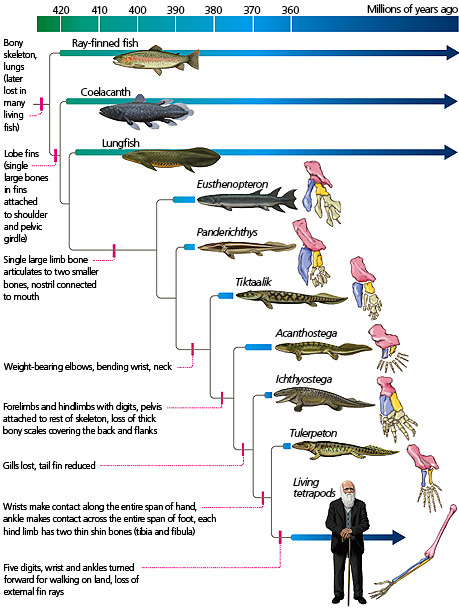
(image id: a scientific diagram depicting the taxonomic relationships of early lobe-finned fish showing their evolution to proto-tetrapods like Tiktaalik and Ichthyostega, to true tetrapods. Source)
There are two known living coelacanth species: the west Indian ocean coelacanth (Latimeria chalumnae) and the Indonesian coelacanth (L. menadoensis). Both are very large fish, capable of exceeding 2 m (6.6 ft) in length and 90 kg (200 lbs). Their wikipedia page describes them as "plump", which seems a little judgmental to me. Their tails are unique, consisting of two lobes above and below the end of the tail, which has its own fin. Their scales are very hard and thick, acting like armor. The mouth is small, but a hinge in its skull, not found in any other animal, allows the mouth to open extremely wide for its size. In addition, they lack a maxilla (upper jawbone), instead using specialized tissue in its place. They lack backbones, instead having an oil-filled notochord that serve the same function. The presence of a notochord is the key characteristic of being a chordate, but most vertebrates only have one in embryo, after which it is replaced by a backbone. Instead of a swim bladder, coelacanths have a vestigial lung filled with fatty tissue that serves the same purpose. In addition to the lung, another fatty organ also helps control buoyancy. The fatty organ is large enough that it forced the kidneys to move backwards and fuse into one organ. Coelacanths have tiny brains. Only about 15% of the skull cavity is filled by the brain, the rest is filled with fat.
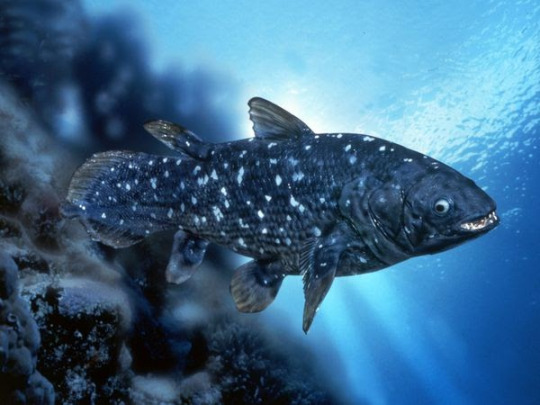
(image id: a coalacanth. It is similar to the one on the above image, but this one is blue in color and the head is seen more clearly, showing an open mouth and large eye)
One of the reasons it took so long for coelacanths to be rediscovered is their habitat. They prefer to live in deeper waters in the twilight zone, between 150 and 250 meters deep. They are also nocturnal and spend the day either in underwater caves or swimming down into deeper water. They typically stay in deeper water or caves during the day as colder water keeps their metabolism low and conserves energy. While they do not appear to be social animals, coelacanths are tolerant of each other's presence and the caves they stay in may be packed to the brim during the day. Coelacanths are all about conserving energy even when looking for food. They are drift feeders, moving slowly with the currents and eating whatever they come across. Their diet primarily consists of fish and squid. Not much is known about how they catch their prey, but they are capable of rapid bursts of speed that may be used to catch prey and is definitely used to escape predators. They are believed to be capable of electroreception, which is likely used to locate prey and avoid obstacles. Coelacanths swim differently than other fish. They use their lobe fins like limbs to stabilize their movements as they drift. This means that while coelacanths are slow, they are very maneuverable. Some have even been seen swimming upside-down or with their heads pointed down.
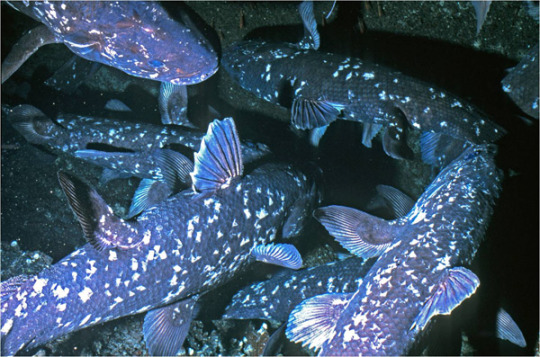
(image: an underwater cave wilt multiple coelacanths residing in it. 5 are clearly visible, with the fins of others showing from offscreen)
Coelacanths are a vary race example of bony fish that give live birth. They are ovoviviparous, meaning the egg is retained and hatches inside the mother. Gestation can take between 2 and 5 years (estimates differ) and multiple offspring are born at a time. It is possible that females may only mate with a single male at a time, though this is not confirmed. Coelacanths can live over 100 years and do not reach full maturity until age 55. This very slow reproduction and maturation rate likely contributes to the rarity of the fish.
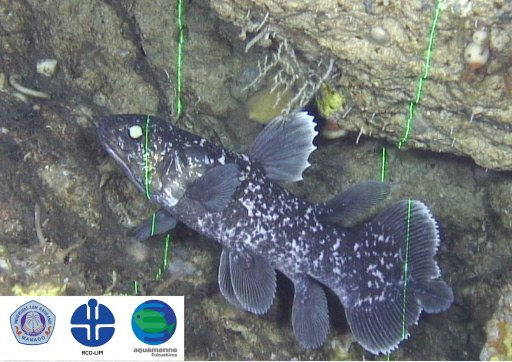
(image: a juvenile coelacanth. Its body shape is the same as those of adults, but with proportionately larger fins. There are green laser beams shining on it. These are used by submersibles to calculate the size of animals and objects)
Coelacanths are often described as living fossils. This term refers to species that are still similar to their ancient ancestors. The term is losing favor amongst biologists due to how misleading it can be. The term os often understood to mean that modern species are exactly the same as ancient ones. This is not the case. Living coelacanth are now known to be different than those who existed during the Cretaceous, let alone the older fossil species. Living fossils often live in very stable environments that result in low selective pressure, but they are still evolving, just slower.
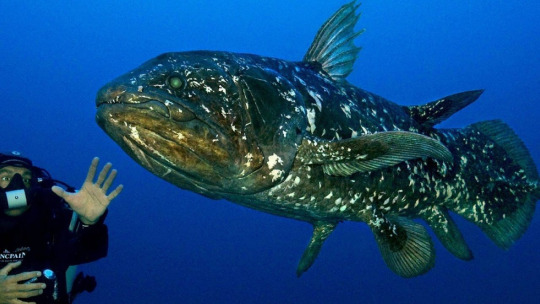
(image: a coelacanth swimming next to a SCUBA diver)
Because of the rarity of coelacanths, it's hard to figure out what conservation needs they have. The IUCN currently classifies the west Indian ocean coelacanth as critically endangered (with an estimated population of less than 500) and the Indonesian coelacanth as vulnerable. Their main threat is bycatch, when they are caught in nets intended for other species. They aren't fished commercially as their meat is very unappetizing, but getting caught in nets is still very dangerous and their slow reproduction and maturation means that it is long and difficult to replace population losses. There is an international organization, the Coelacanth Conservation Council, dedicated to coelacanth conservation and preservation.
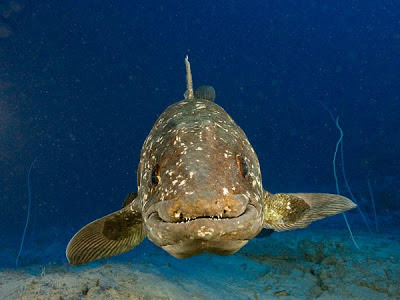
(image: a coelacanth facing the camera. The shape of its mouth makes it look as though it is smiling)
#wet beast wednesday#coelacanth#marine biology#biology#zoology#ecology#animal facts#fish#fishblr#old man fish#lobe-finned fish#sarcopterygii
1K notes
·
View notes
Text
Round 2 - Chordata - Actinistia


(Sources - 1, 2)
The Sarcopterygians (“Lobe-finned Fishes”), are the last of the three groups of “fish”, and are so named for the prominent muscular limb buds (lobes) within their fins. Of the Sarcopterygians living today, they are represented by the coelacanths, lungfish, and tetrapods (including humans), who all diverged in the Silurian. These next fish are closer related to us than they are to Actinopterygiians.
The class Actinistia, the “Coelacanths”, are an ancient group of fish that have been around since the Devonian but today are only represented by two remaining species: The West Indian Ocean Coelacanth (Latimeria chalumnae) and the Indonesian Coelacanth (Latimeria menadoensis).
Coelacanths can live as deep as 700 m (2,300 ft) below the sea, but are more commonly found at depths of 90 to 200 m (300 to 660 ft). They have sensitive eyes which include a tapetum lucidum and many rods which help them see better in dark water, as they are most active at night. They are opportunistic hunters, feeding on cuttlefish, squid, snipe eels, small sharks, and other fish found around their deep reef and volcanic slope habitats. Their abundance of fins allow for high maneuverability, and coelacanths can orient their body in almost any direction in the water. They have been seen doing headstands as well as swimming belly up. They are able to slow their metabolisms at will, sinking into less-inhabited depths and going into a hibernation mode to conserve energy.
Coelacanths are ovoviviparous, with the female retaining the fertilized eggs within her body while the embryos develop over a gestation period of five years. The female will give live birth to around 5-26 young. Young coelacanths resemble the adult, but carry an external yolk sac below their pelvic fins, and have larger eyes relative to body size. Individual coelacanths may live as long as 80 to 100 years.
Coelacanths get their name from Coelacanthus, a genus of Permian coelacanths and the first coelacanths to be described. Over 100 fossil species are known, and all of them were believed to have gone extinct in the Cretaceous. On December 23, 1938, the first Latimeria specimen was discovered among the catch of a South African fisherman, making coelacanths a “lazarus taxon.” While previously considered a “living fossil”, coelacanth body shapes were much more diverse in the Early Triassic, and Latimeria is not known from fossils, showing that it had to have gone through some changes to adapt to the modern day.

Propaganda under the cut:
Since there are only two living species in this class and both are threatened, this is the most endangered class of animals in the world.
Coelacanths get along with other coelacanths, though they recoil from physical touch. Scientists think that they recognize each other via electric communication.
Mawsonia was one of the largest known coelacanths, with one specimen estimated at over 5 m (16 ft) long. It lived from the Late Jurassic to Mid-Cretaceous.
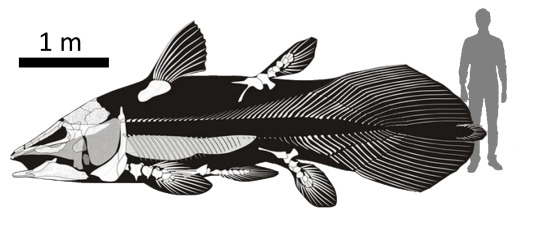
(source)
90 notes
·
View notes
Text
A Closer Look: Vertebrates

The Vertebrata clade can be split into 3 main groups: neomammalia (new mammals) and brachipteryxus (wing-armed) - the tetrapods; as well as polypodus (many-footed) - their distant six-legged cousins.



Examples of chordates: Dolichocerca leo, the ocelot (neomammalia); Lepidoscelus igneamantis, the strider (brachipteryxus); and Neopolypodus flavitta, the bee (polypodus).
Neomammalia and brachipteryxus are both notable survivors of Primordial Death, the mass-extinction event that eliminated the majority of life in the realms prior to the players’ entry. Neomammalia in particular had many surviving members, and has since continued to diversify.
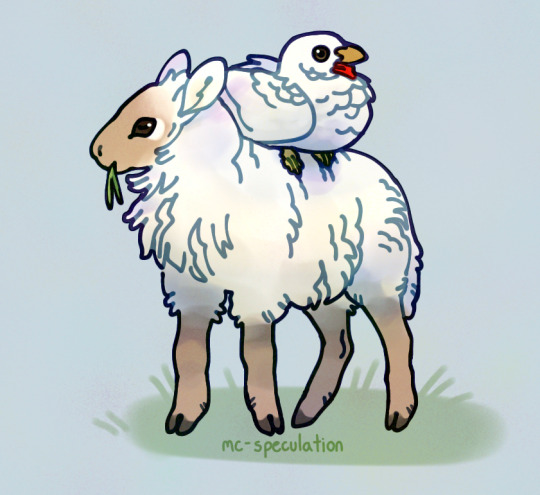
A chicken (Myriapinna polynativas) and a sheep (Lanatumorphus myriachroma), both survivors of Primordial Death.
Polypodus is considered a lazarus taxon - a group of organisms that was considered extinct, but reappeared later. Bees were discovered first - long after the players’ emergence - and defined the previously unknown polypodus taxon. It was believed they were the only extant polypod, until ancient sniffer eggs were discovered - and miraculously hatched.

A snifflet (juvenile Anchipolypodus aeternovis).
Return to full tree.
Neomammalia.
Brachipteryxus.
147 notes
·
View notes
Text
it's always "the coelacanth is a Lazarus taxon" and never "Lazarus was a coelacanth person" 🙄
284 notes
·
View notes
Text













having normal thoughts about one steve rogers, thanks @itsalmostavengers
glacial erratic / armada by the ballroom thieves / jte by the ghost of paul revere / take me to war by the crane wives / extinction dept /trouble by the ballroom thieves / family portrait by radical face / siren by the ghost of paul revere / lazarus taxon / fistfight by the ballrooom thieves / take me to war by the crane wives / black eye by radical face / in defense of plants ep 382
#i think about steve as a glacial erratic a lot#just first the term. erratic. is so good.#but just. something dragged into a place it never should have been by glacial ice#yeah. yeah. extinction debt. lazarus taxa. range collapse.#you get it. right you get it. anyways going insane now.
28 notes
·
View notes
Text

Who would win, a devastating volcanic eruption, or one mousey boi?
The answer may surprise you.
#Apomys sacobianus#pinatubo mouse#mouse#mice#artists on tumblr#art#illustration#artwork#myart#original art#digital art#digitalart#digital illustration#digital drawing#animal art#mount pinatubo#volcano#volcanoes#volcanic eruption#lazarus taxon
5 notes
·
View notes
Text
ShiIta Fanfic Fundraising for Gaza
Inspired by Eeri's GaaLee fics for Gaza, I will also be offering ShiIta fics in exchange for donations to families in need who are currently raising funds to survive in and relocate from Gaza. If you are interested in receiving a fic from me, please read below to decide what works best for you. (Please note that proof donation will be required for ALL fics!):
$5 = a new fic under 5,000 words
$10 = a new fic under 10,000 words
$50 = a vignette for an existing fic that is NOT a new chapter
$100 = an update for an existing fic that IS a new chapter
Campaigns To Donate To:
Help Eman and her three children evacuate from Gaza (currently at €2,256)
Help Mohammed and his family gather supplies and save to evacuate (currently at $5,015)
Help Eman and her two children purchase food, diapers, and other needed supplies (currently at $2,251)
Help Seham's family evacuate from Gaza (currently at £370)
Help Dr. Maryam evacuate her family from Gaza (currently at €1,100)
Help Shoroq and her family evacuate from Gaza (currently at $1,726)
Help Walaa and her family leave Gaza to receive life-saving medical care (currently at €562)
Help Amal and her children to gather supplies and eventually evacuate from Gaza (currently at $2,240)
Help Dyana, her husband, and child evacuate from Gaza (currently at €990)
Help Aseel and her family rebuild their lives (currently at €510)
How It Works:
After donating, send a screenshot to me via Tumblr or Twitter (@vulcanitachi) that includes your name and the amount that you donated.
I will only be writing for ShiIta. If there is a side-pairing you want me to include, depending on the ship I may include it but it's not guaranteed if it's a personal NOTP.
I accept both AUs and canon-verse, but will not write major character death.
If you donate, you're more than welcome to request a prompt, but I reserve the right not to write it if it contains material I personally would not feel comfortable producing.
Multiple donations to multiple campaigns can either be used for multiple fics or pooled together to get a vignette or update depending on the amount. Just tell me what you want!
Currently, there's no limit to the amount of fics I will write, but this may change if I (unexpectedly) get overwhelmed with requests.
Once I receive proof of donation, I will be doing my best to post as quickly as possible, but anyone who follows my work knows I operate on a slower posting schedule, so patience is appreciated!
Fics I will considering updating include: lazarus taxon, wanna be on your mind (stay there all the time), the currently in-progress sequel for pack up (don't stray), and the currently in-progress sequel to our hungers appeased. I will NOT be offering the next chapter to lovers alone wear sunlight at this time because it's still under major construction and I am not confident I could complete it in a timely manner.
If you cannot donate the minimum amount to get a fic, even sending $1 or sharing this post helps more than you can know. Please note that the above campaigns are just a fraction of the people who desperately need our help to escape occupation and genocide. Thank you everyone for reading and a big thanks for anyone who elects to participate.
15 notes
·
View notes
Text




I got to draw for a school project application. The alternate name was Lazarus Taxons.
(Click for full res)
#my art#illustration#digital art#artists on tumblr#doodles#digital illustration#art#stephen jay gould#carl sagan#julian huxley#science#biology#evolution#fossils
12 notes
·
View notes
Text
₊˚ ⊹ ☆ WYUOVVIA ♡︎ LAZARUS TAXON ୨ৎ
professional rizzler , firefly & lyney main , artist writer and editor
✦ ݂ ͘ ౨ৎ she/he , minor , infp , leo - tumblr blogger who creates smut and sfw jjk, hsr, and genshin fanfics! requests are always open; please check the rules before requesting and take a look at the masterlist and wips too! if you wish to add me on my other social media accounts, you can find them here! also pls check out my mutuals they are all awesome sauce!!



3 notes
·
View notes
Text
good ending (highly unlikely) (near impossible): thylacines become a lazarus taxon
bad ending (almost 100% definitely what happened): forrest galante finally widely exposed as a bitch ass liar
#vic.txt#edit i already know hes a liar n scammer but like maybe itll become more widely known if he lies abt smth this big
4 notes
·
View notes
